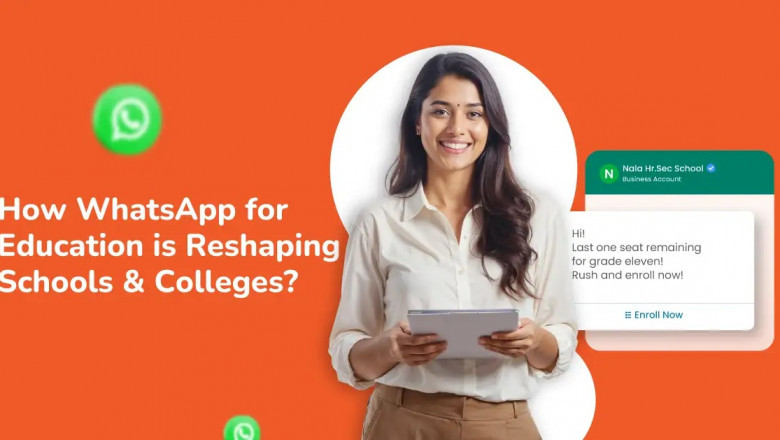views
The education landscape has undergone a massive transformation with the integration of digital tools. Among these, WhatsApp has emerged as a powerful platform for enhancing communication and collaboration in education. With its user-friendly interface and widespread accessibility, WhatsApp for education is enabling new ways of teaching, learning, and administrative management. This article explores how WhatsApp is shaping the future of education, its key benefits, and practical applications in various educational settings.
Why WhatsApp Is Ideal for Education
WhatsApp has over 2 billion users worldwide, making it one of the most accessible communication tools. Its ability to support text, voice, video, and multimedia sharing has positioned it as a versatile tool for education. Here's why it stands out:
-
Ease of Use: Its intuitive interface ensures that students, teachers, and parents can adopt it without a steep learning curve.
-
Global Reach: WhatsApp’s widespread adoption ensures that it can bridge communication gaps even in remote areas.
-
Cost-Effectiveness: With minimal data requirements, WhatsApp for education is affordable and sustainable.
-
Real-Time Communication: Instant messaging and notifications enable swift updates and engagement.
-
Multimedia Support: The ability to share images, videos, documents, and voice notes enriches the learning experience.
Key Benefits of WhatsApp for Education
1. Enhanced Teacher-Student Communication
Teachers can use WhatsApp to provide timely feedback, answer questions, and offer additional resources. This real-time interaction helps students stay motivated and engaged.
2. Streamlined Administration
WhatsApp simplifies communication between administrators, teachers, parents, and students. From scheduling meetings to disseminating important announcements, it ensures seamless coordination.
3. Collaborative Learning
Group chats and broadcast lists foster collaborative learning. Students can share ideas, participate in discussions, and work on group projects with ease.
4. Accessibility for All
WhatsApp’s minimal data consumption and mobile-friendly features make it accessible to students and teachers in low-resource environments.
5. Personalized Learning
Educators can use WhatsApp to send tailored resources, such as video tutorials, worksheets, and personalized feedback, catering to individual student needs.
Applications of WhatsApp in Education
1. Virtual Classrooms
WhatsApp facilitates virtual learning environments, especially in regions with limited access to advanced e-learning platforms. Teachers can share lesson plans, conduct quizzes, and host discussions directly on the platform.
2. Parent-Teacher Communication
WhatsApp enables effective communication between parents and teachers. Progress updates, behavioral feedback, and event notifications can be shared instantly, fostering transparency.
3. Peer-to-Peer Learning
Students can form study groups to share notes, clarify doubts, and collaborate on projects. Peer-to-peer interaction boosts engagement and knowledge retention.
4. Resource Sharing
Teachers can use WhatsApp to share multimedia resources, such as video lectures, infographics, and PDFs, enriching the curriculum and making learning more dynamic.
5. Surveys and Feedback
Educational institutions can use WhatsApp to conduct surveys and gather feedback from students, parents, and teachers. This helps in understanding their needs and improving processes.
Case Studies: WhatsApp for Education in Action
Case Study 1: Remote Learning in Rural Areas
A school in a remote village implemented WhatsApp as a primary tool for virtual learning during the pandemic. Teachers shared lesson videos, assignments, and real-time feedback. The result was a 70% improvement in student engagement compared to pre-pandemic levels.
Case Study 2: Enhanced Parent Engagement
An urban school used WhatsApp to send personalized progress updates and reminders about parent-teacher meetings. This led to a 50% increase in parental participation in school activities.
Case Study 3: Peer Collaboration in Higher Education
A university encouraged students to use WhatsApp for project collaboration. The platform’s multimedia sharing capabilities allowed students to exchange research materials, draft presentations, and communicate effectively, resulting in higher project grades.
Challenges and Solutions
While WhatsApp for education offers numerous benefits, there are challenges to address:
-
Information Overload: Overuse of WhatsApp groups can overwhelm participants. Solution: Set clear guidelines for group communication.
-
Privacy Concerns: Sharing personal contact details can raise privacy issues. Solution: Use broadcast lists instead of groups when possible.
-
Distraction: The informal nature of WhatsApp can lead to distractions. Solution: Encourage disciplined usage and set specific times for educational interactions.
-
Digital Divide: Not all students may have access to smartphones or stable internet. Solution: Provide offline resources and explore partnerships for affordable devices.
Best Practices for Using WhatsApp in Education
-
Define Clear Objectives: Establish goals for using WhatsApp in your educational setup.
-
Use Broadcast Lists: Avoid group clutter and maintain privacy by using broadcast lists for one-to-many communication.
-
Set Communication Etiquette: Develop guidelines for respectful and focused discussions.
-
Leverage Multimedia: Use images, videos, and voice notes to make learning engaging and interactive.
-
Monitor and Evaluate: Regularly assess the effectiveness of WhatsApp in achieving educational goals.
The Future of WhatsApp for Education
As technology evolves, WhatsApp’s role in education will continue to grow. Future developments may include:
-
AI Integration: Intelligent bots could assist with FAQs, quizzes, and assignment tracking.
-
Enhanced Security: Advanced encryption and privacy features will address concerns around data safety.
-
Dedicated Education Features: WhatsApp may introduce features specifically tailored for educational use, such as attendance tracking and LMS integration.
-
Global Collaborations: Institutions worldwide could use WhatsApp to foster cross-cultural exchanges and collaborative projects.
Conclusion
WhatsApp for education is transforming the way knowledge is imparted and absorbed. Its accessibility, cost-effectiveness, and versatility make it a valuable tool for educators, students, and administrators alike. By addressing challenges and adopting best practices, educational institutions can harness the full potential of WhatsApp, paving the way for innovative and inclusive learning experiences. Whether you’re a teacher looking to enhance engagement or an administrator aiming for streamlined communication, WhatsApp is a platform worth exploring for the future of education.






















Comments
0 comment